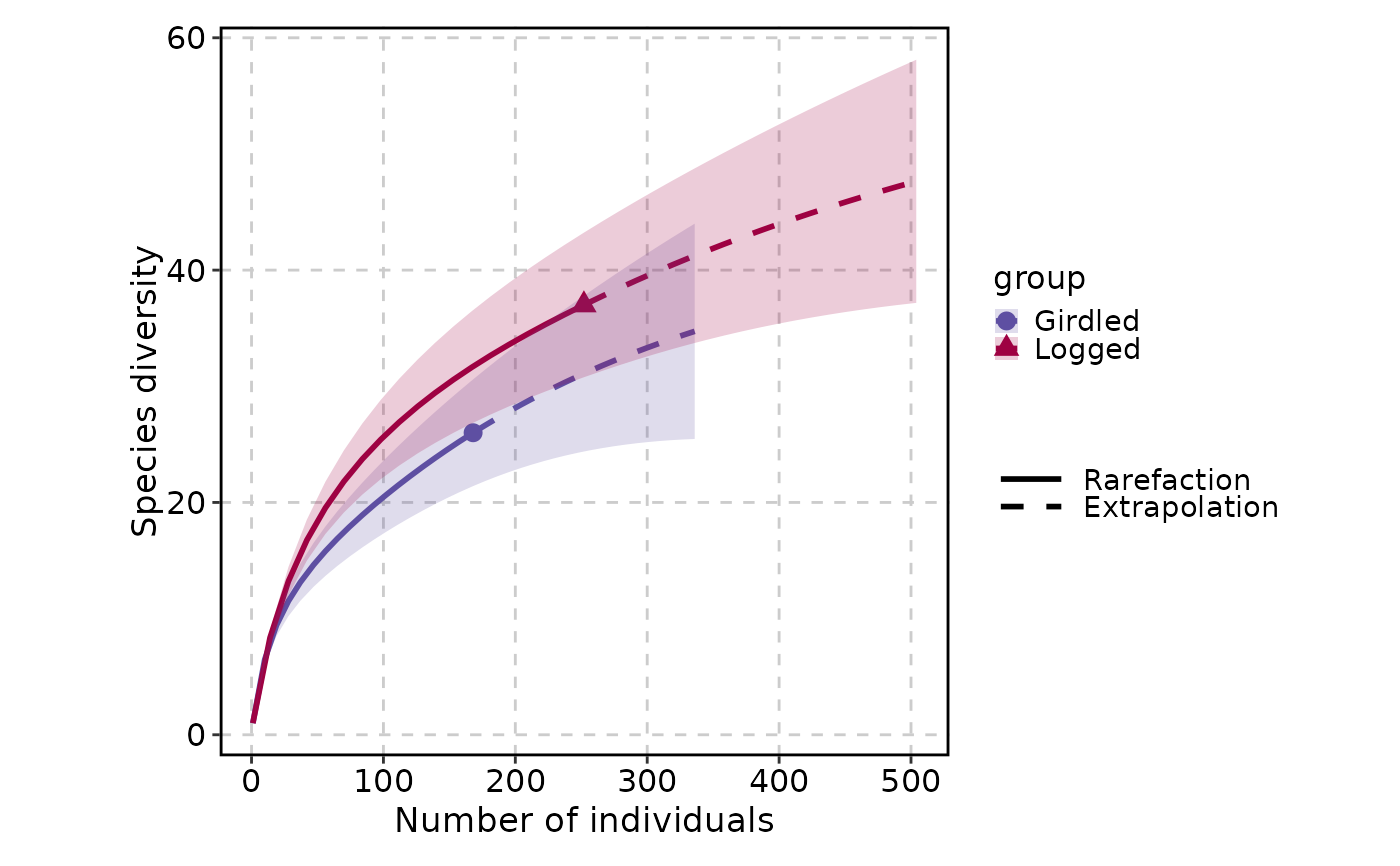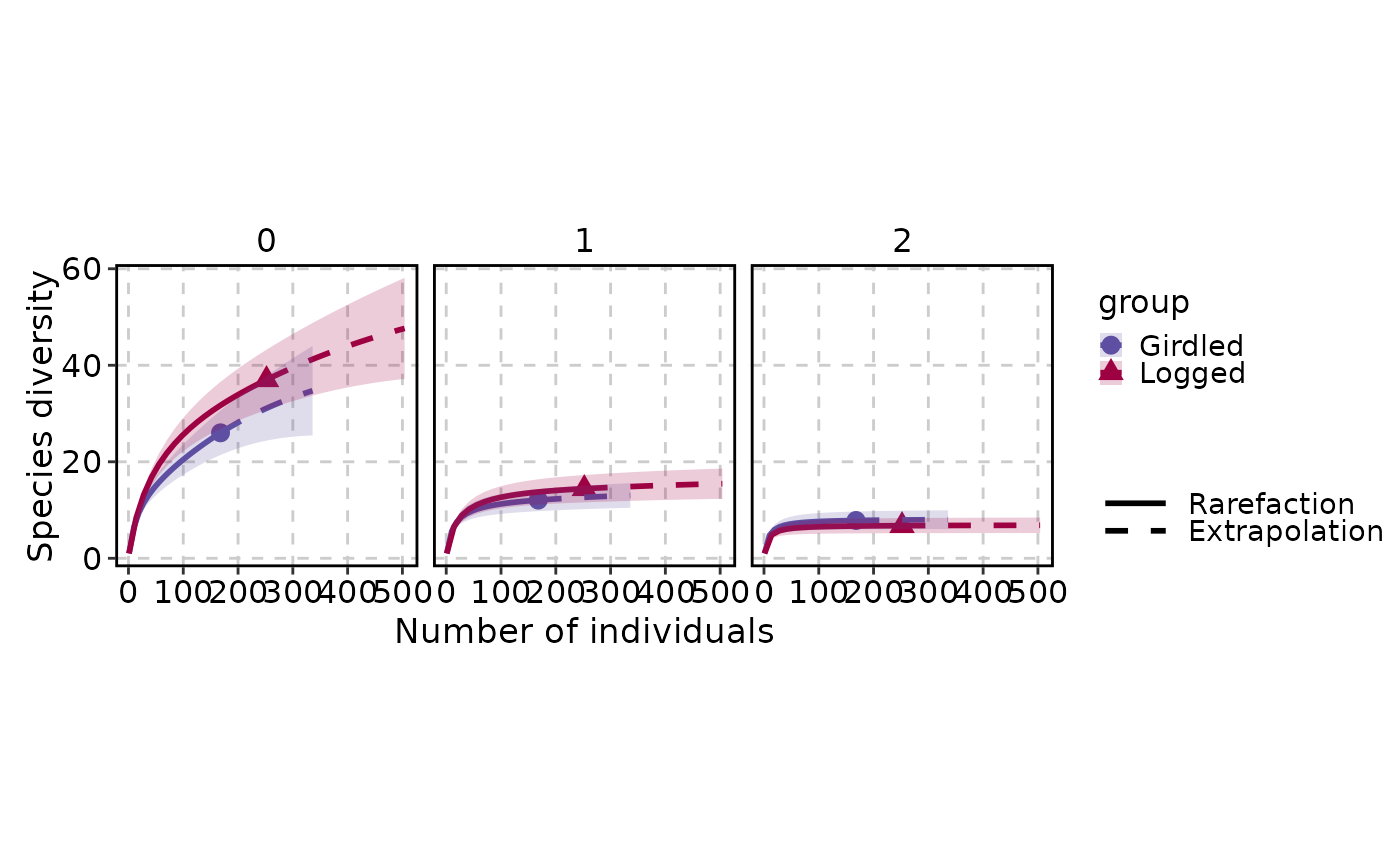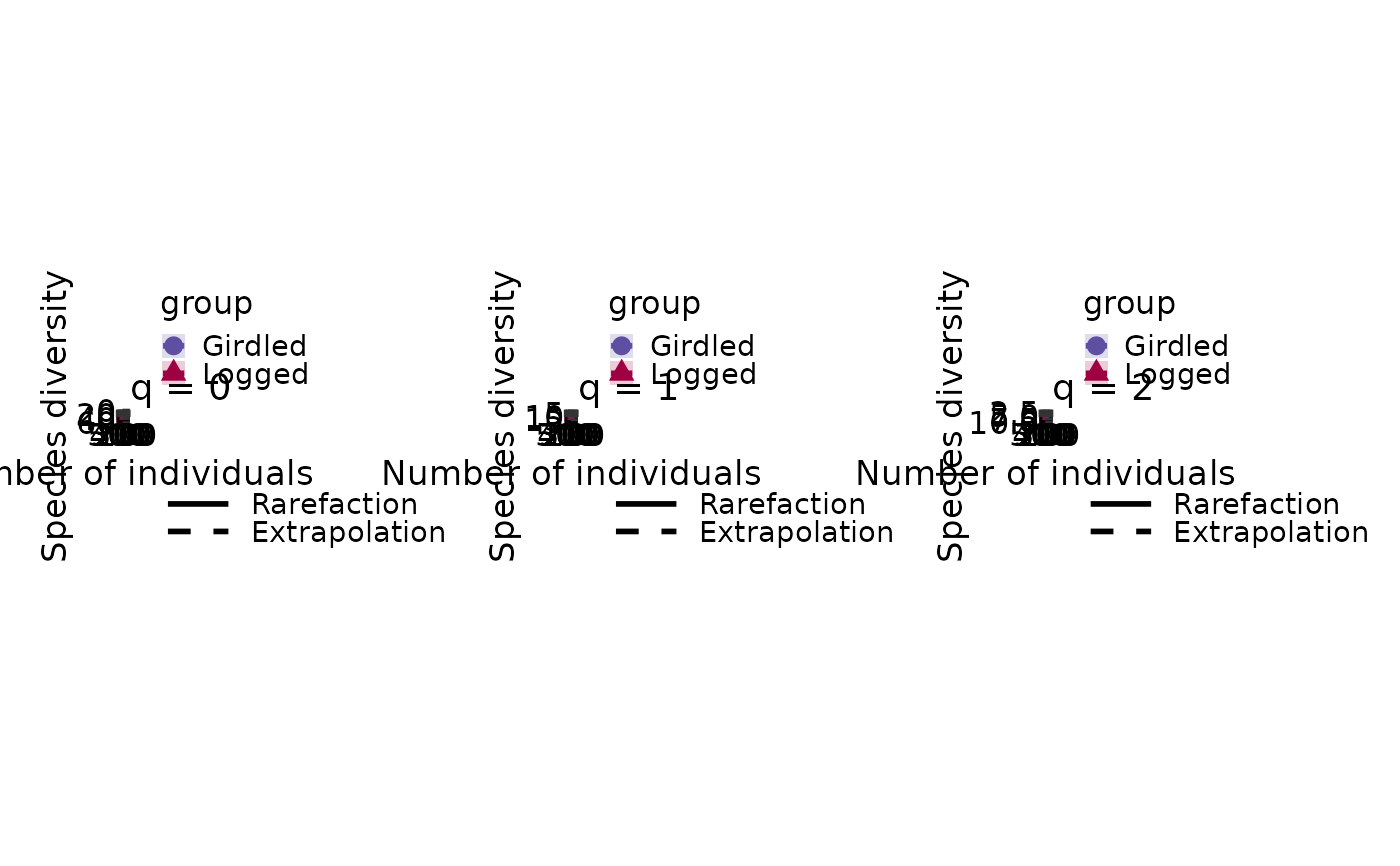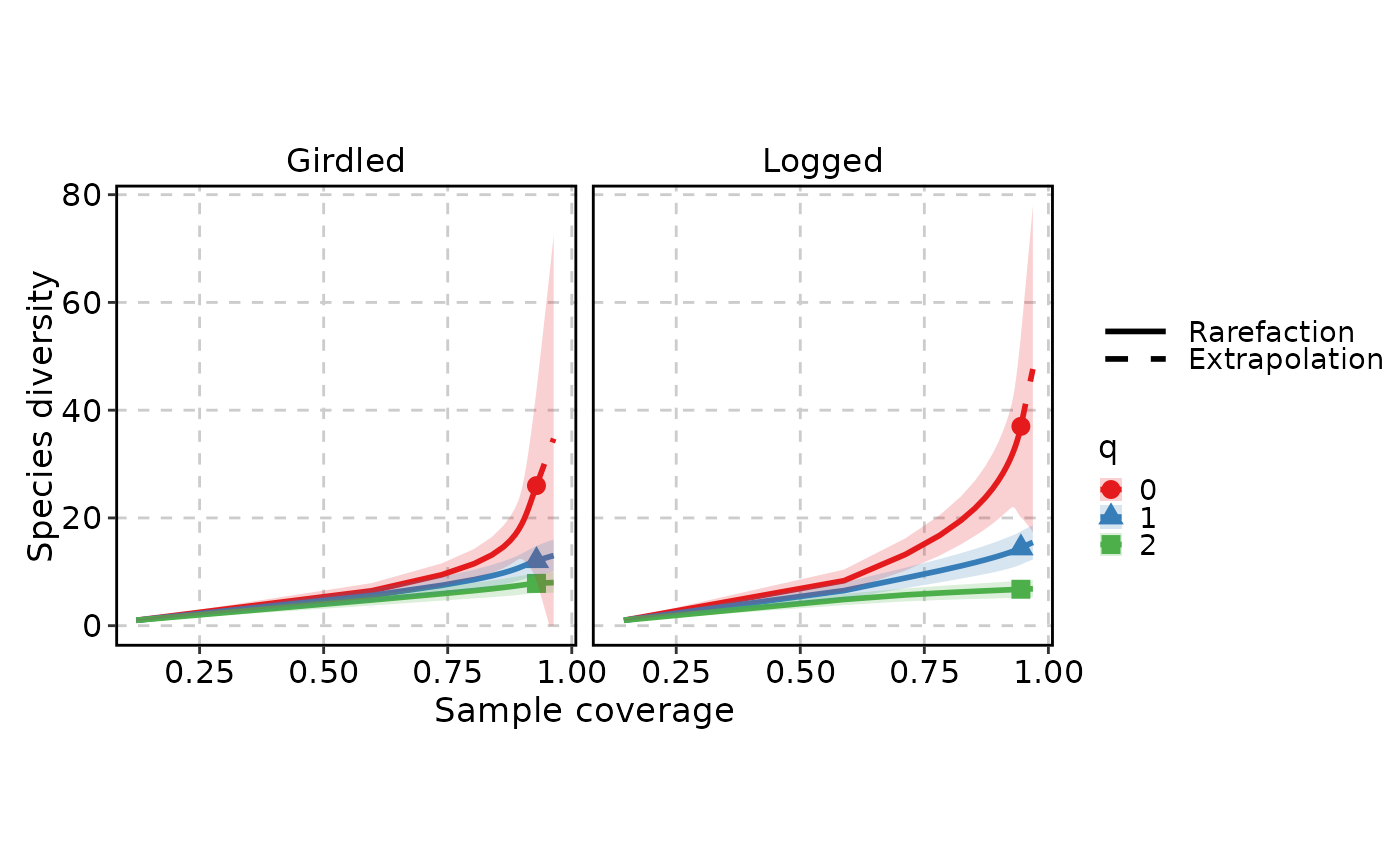This function generates a rarefraction plot for a given dataset.
Usage
RarefactionPlot(
data,
type = 1,
se = NULL,
group_by = "group",
group_by_sep = "_",
group_name = NULL,
split_by = NULL,
split_by_sep = "_",
theme = "theme_this",
theme_args = list(),
palette = "Spectral",
palcolor = NULL,
alpha = 0.2,
pt_size = 3,
line_width = 1,
facet_by = NULL,
facet_scales = "fixed",
facet_ncol = NULL,
facet_nrow = NULL,
facet_byrow = TRUE,
aspect.ratio = 1,
legend.position = "right",
legend.direction = "vertical",
title = NULL,
subtitle = NULL,
xlab = NULL,
ylab = NULL,
seed = 8525,
combine = TRUE,
nrow = NULL,
ncol = NULL,
byrow = TRUE,
axes = NULL,
axis_titles = axes,
guides = NULL,
design = NULL,
...
)Arguments
- data
A data frame.
- type
three types of plots: sample-size-based rarefaction/extrapolation curve (
type = 1); sample completeness curve (type = 2); coverage-based rarefaction/extrapolation curve (type = 3).- se
a logical variable to display confidence interval around the estimated sampling curve. Default to
NULLwhich means TRUE if the data has the lower and upper bounds.- group_by
Columns to group the data for plotting For those plotting functions that do not support multiple groups, They will be concatenated into one column, using
group_by_sepas the separator- group_by_sep
A character string indicating how to separate the group_by column if both "q" and "group" are used. for 'group_by'. Default to "_".
- group_name
A character string indicating the name of the group, showing as the legend title.
- split_by
A character string indicating how to split the data and plots Possible values are "q" and "group"
- split_by_sep
The separator for multiple split_by columns. See
split_by- theme
A character string or a theme class (i.e. ggplot2::theme_classic) specifying the theme to use. Default is "theme_this".
- theme_args
A list of arguments to pass to the theme function.
- palette
A character string specifying the palette to use. A named list or vector can be used to specify the palettes for different
split_byvalues.- palcolor
A character string specifying the color to use in the palette. A named list can be used to specify the colors for different
split_byvalues. If some values are missing, the values from the palette will be used (palcolor will be NULL for those values).- alpha
A numeric value specifying the transparency of the plot.
- pt_size
A numeric value specifying the size of the points.
- line_width
A numeric value specifying the width of the lines.
- facet_by
A character string specifying the column name of the data frame to facet the plot. Otherwise, the data will be split by
split_byand generate multiple plots and combine them into one usingpatchwork::wrap_plots- facet_scales
Whether to scale the axes of facets. Default is "fixed" Other options are "free", "free_x", "free_y". See
ggplot2::facet_wrap- facet_ncol
A numeric value specifying the number of columns in the facet. When facet_by is a single column and facet_wrap is used.
- facet_nrow
A numeric value specifying the number of rows in the facet. When facet_by is a single column and facet_wrap is used.
- facet_byrow
A logical value indicating whether to fill the plots by row. Default is TRUE.
- aspect.ratio
A numeric value specifying the aspect ratio of the plot.
- legend.position
A character string specifying the position of the legend. if
waiver(), for single groups, the legend will be "none", otherwise "right".- legend.direction
A character string specifying the direction of the legend.
- title
A character string specifying the title of the plot. A function can be used to generate the title based on the default title. This is useful when split_by is used and the title needs to be dynamic.
- subtitle
A character string specifying the subtitle of the plot.
- xlab
A character string specifying the x-axis label.
- ylab
A character string specifying the y-axis label.
- seed
The random seed to use. Default is 8525.
- combine
Whether to combine the plots into one when facet is FALSE. Default is TRUE.
- nrow
A numeric value specifying the number of rows in the facet.
- ncol
A numeric value specifying the number of columns in the facet.
- byrow
A logical value indicating whether to fill the plots by row.
- axes
A string specifying how axes should be treated. Passed to
patchwork::wrap_plots(). Only relevant whensplit_byis used andcombineis TRUE. Options are:'keep' will retain all axes in individual plots.
'collect' will remove duplicated axes when placed in the same run of rows or columns of the layout.
'collect_x' and 'collect_y' will remove duplicated x-axes in the columns or duplicated y-axes in the rows respectively.
- axis_titles
A string specifying how axis titltes should be treated. Passed to
patchwork::wrap_plots(). Only relevant whensplit_byis used andcombineis TRUE. Options are:'keep' will retain all axis titles in individual plots.
'collect' will remove duplicated titles in one direction and merge titles in the opposite direction.
'collect_x' and 'collect_y' control this for x-axis titles and y-axis titles respectively.
- guides
A string specifying how guides should be treated in the layout. Passed to
patchwork::wrap_plots(). Only relevant whensplit_byis used andcombineis TRUE. Options are:'collect' will collect guides below to the given nesting level, removing duplicates.
'keep' will stop collection at this level and let guides be placed alongside their plot.
'auto' will allow guides to be collected if a upper level tries, but place them alongside the plot if not.
- design
Specification of the location of areas in the layout, passed to
patchwork::wrap_plots(). Only relevant whensplit_byis used andcombineis TRUE. When specified,nrow,ncol, andbyroware ignored. Seepatchwork::wrap_plots()for more details.- ...
Additional arguments.
Examples
# \donttest{
set.seed(8525)
spider <- list(
Girdled = c(46, 22, 17, 15, 15, 9, 8, 6, 6, 4, rep(2, 4), rep(1, 12)),
Logged = c(88, 22, 16, 15, 13, 10, 8, 8, 7, 7, 7, 5, 4, 4, 4, 3, 3, 3, 3,
2, 2, 2, 2, rep(1, 14))
)
RarefactionPlot(spider)
 RarefactionPlot(spider, q = c(0, 1, 2), facet_by = "q")
RarefactionPlot(spider, q = c(0, 1, 2), facet_by = "q")
 RarefactionPlot(spider, q = c(0, 1, 2), split_by = "q")
RarefactionPlot(spider, q = c(0, 1, 2), split_by = "q")
 RarefactionPlot(spider, q = c(0, 1, 2), split_by = "q",
palette = c("0" = "Paired", "1" = "Set1", "2" = "Dark2"))
RarefactionPlot(spider, q = c(0, 1, 2), split_by = "q",
palette = c("0" = "Paired", "1" = "Set1", "2" = "Dark2"))
 RarefactionPlot(spider, q = c(0, 1, 2), group_by = "q",
facet_by = "group", palette = "Set1", type = 3)
RarefactionPlot(spider, q = c(0, 1, 2), group_by = "q",
facet_by = "group", palette = "Set1", type = 3)
 # }
# }
